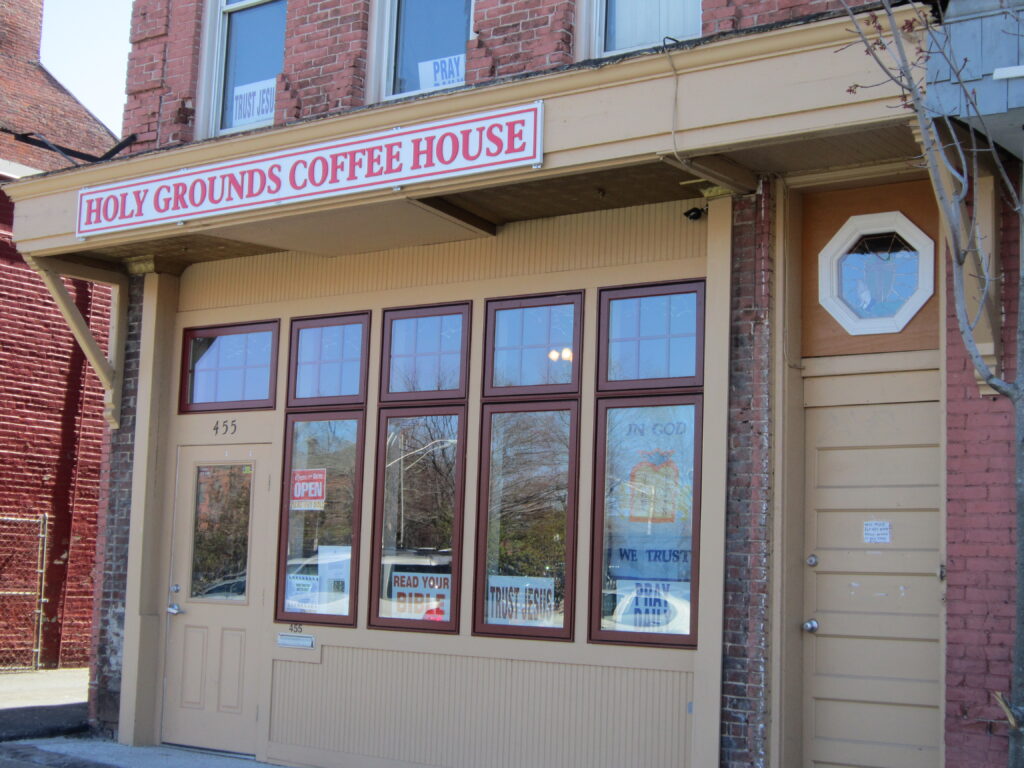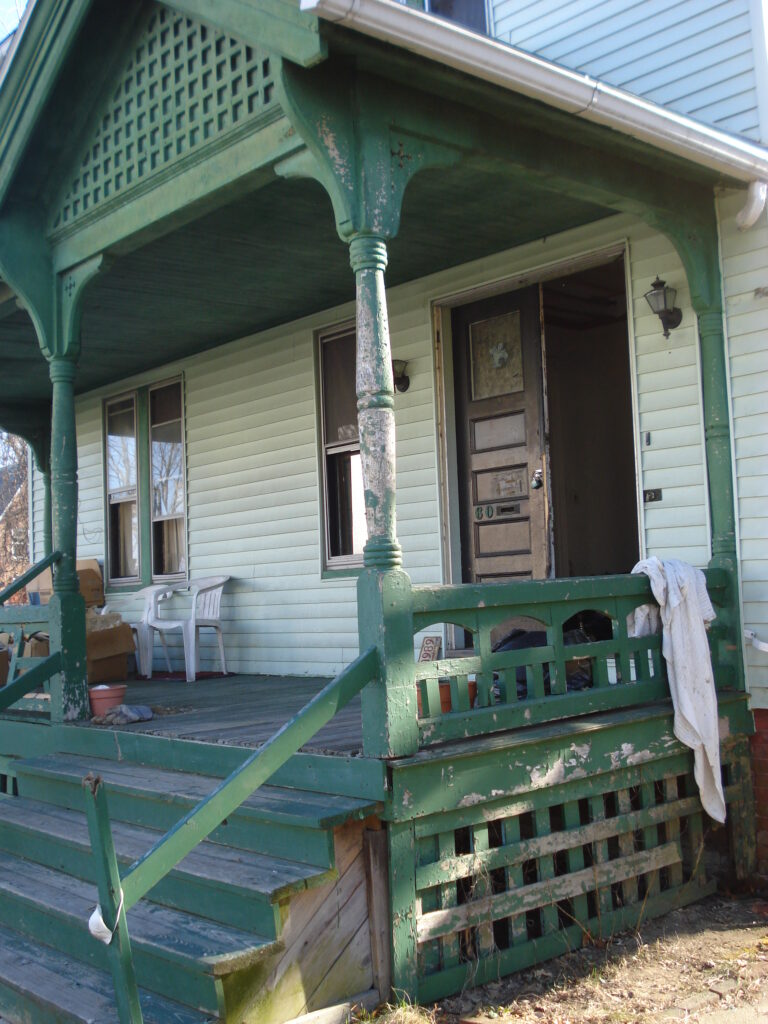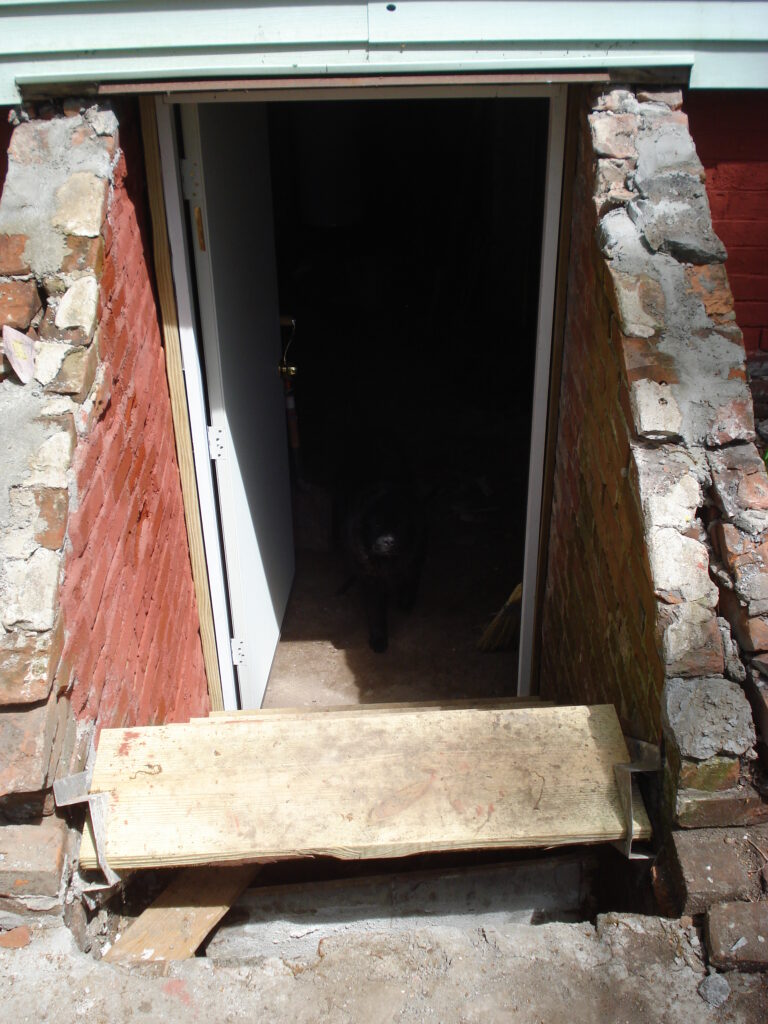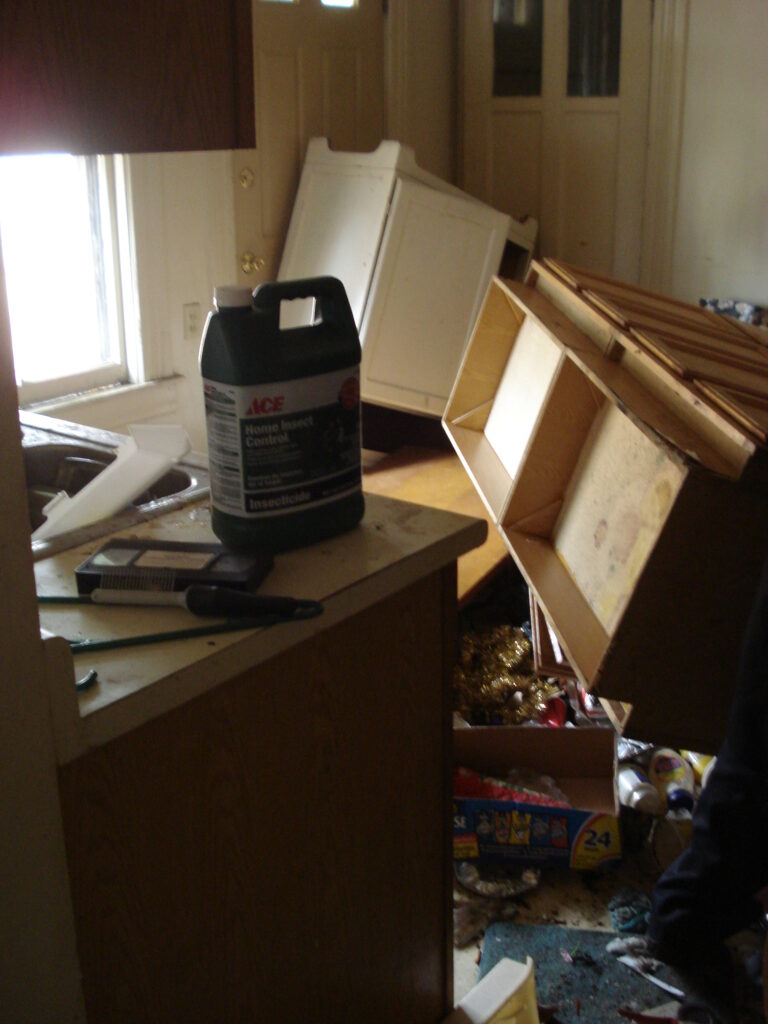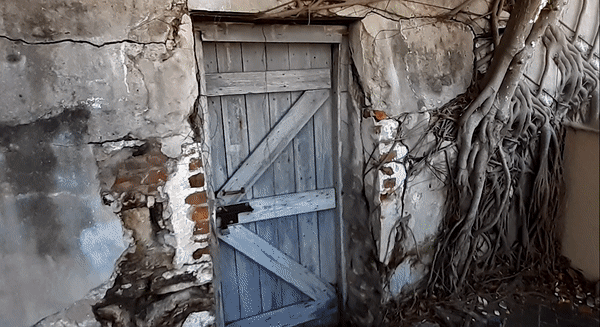The Encouraging Story of the Redemption Gate Mission
and its Holy Grounds Coffee House Model
for Re-Christianizing “Post-Christian” Cities.
By Pastor Scott Lively
Should you or someone you know be in this book? Can you help identify people in the photos whose names we’ve forgotten? Do you have a personal testimony about the Redemption Gate Mission’s impact on your life? Do you have a top quality photo we should include? Contact Pastor Scott directly at scottlivelyministries@protonmail.com .
Chapter One: A Mission of Restoration
It was the year 2004. Traditional values and perspectives were under attack like never before all across America, but the wave of unwelcome change was hitting Massachusetts hardest as its liberal courts volunteered to make the Bay State – the cradle of Puritan Christianity in the New World – the first state to “legalize” so-called “Gay Marriage.” The City of Springfield, the largest city and hub of the most western third of the state, was particularly sensitive to the pain of this change. Springfield was the “unwanted step-child” of Massachusetts urban centers: the place where the Boston elites sent the “dregs” of their social welfare and entitlement systems to be pooled together in one distant, inner-city pond, creating what one insightful former state employee (and later a pillar of the Holy Grounds team) termed “The Catfish Farm.”
The Catfish Farm was a system for containing a high concentration of the poor and disadvantaged of every type within a ring of social service agencies who used them as federal entitlement “cash cows” to siphon money from federal tax-funded reservoirs into state coffers. As little as possible of that money was used to serve the basic needs of the “catfish” people, while the remainder funded the establishment and maintenance of a giant army of social service workers organized in socialist-style public employee unions with the power to control local elections for the perpetual self-preservation of the elites — and to engineer social change.
And, of course, those Massachusetts elites were closely aligned and intertwined with organized crime – the literal Mafia – which operated its own parallel systems of grift and graft in cooperation with local government. We’ll address that issue shortly.
Within Springfield’s system of exploitation and pseudo-slavery there was one primary bastion of hope and solace for inner-city families and individuals: the Black church, serving the overwhelmingly African-America community which made up probably 65-70% of the population. And among the Black pastors in that wide network of congregations was one especially stalwart Man of God, whose very name exemplified his role among his people: “Constant.” Pastor Constant “Steve” Cooley was an anchorman of courage and constancy-of-faith whom God called to stand against the normalization of “gay marriage” in a lonely, sign-holding vigil on the steps of Springfield City Hall. Alone of the inner-city clergy, he dared to publicly buck the dominant liberal social order. Although many stopped to offer their encouragement and support privately, Pastor Cooley stood alone, day after day, week after week, until the Holy Spirit told him to “Go home and wait for my signal to arise.”
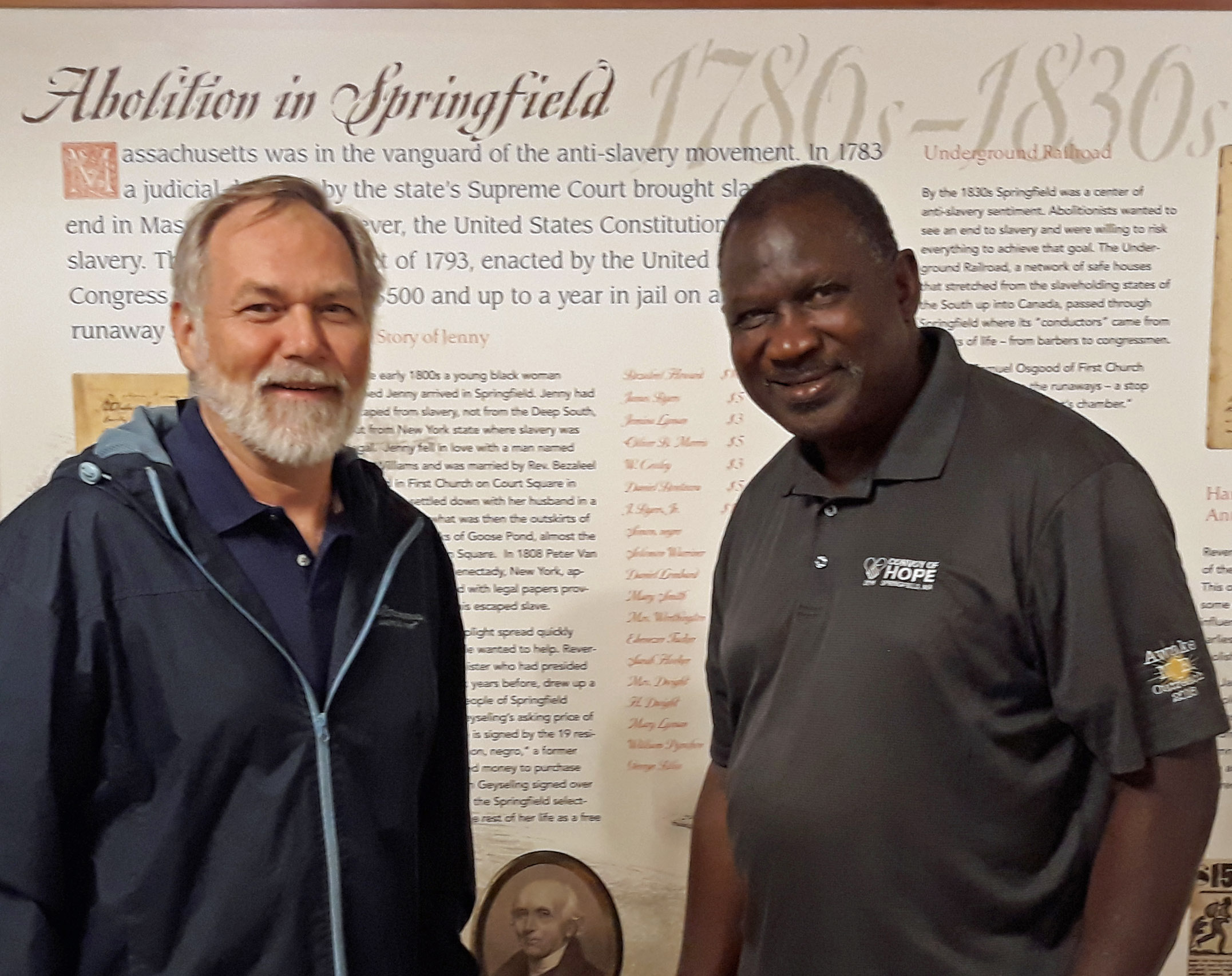
Meanwhile, on the opposite side of the country, in ultra-liberal California, another stalwart Christian traditionalist fought his own battle in the same war: your author: attempting to stop “gay marriage” in the courts in his role as Managing Partner of the small Temecula-based Christian law firm, Lively, Ackerman and Cowles, and its non-profit public-interest sister organization The Pro-Family Law Center. The PFLC was the only law firm in the nation which filed an Amicus Brief with the US Supreme Court before it accepted Lawrence v Texas, strongly urging the justices to reject Lawrence for review – knowing that the only purpose the court could have for review would be to help swing-Justice Anthony Kennedy take another axe to America’s Judeo-Christian roots in homosexual matters.
Sure enough, Kennedy not only struck down the Texas sodomy laws in his majority opinion in Lawrence, he went much further and struck down Bowers v Hardwick, the 1986 game-changer of the Reagan Era which had fully blocked the normalization of homosexual sodomy nationwide in America and affirmed the right of states to regulate sexual conduct in the public interest. The overturning of Bowers was the legal equivalent of blowing up Hoover Dam and allowed the LGBT agenda to flood across the nation like a tsunami of licentiousness – all the way to Massachusetts where it took the form of “legalizing” “gay marriage” by state court judicial fiat, facilitated by uber-RINO, then-Governor Mitt Romney.

What followed for Pastors Cooley and Lively – who would not yet meet for another four years – was a time of coping in their own ways with the increasing disintegration of protections for biblical marriage and the natural family. Pastor Cooley returned to his flock and focused on the constant struggles of inner-city life in the Catfish Farm.
Attorney Lively, after a couple of other major attempts to fight the LGBT agenda in the US courts, realized the war could not be won on that battlefield, turned over his law practice to his partners, and in mid-2006 began the months-long transitional process of returning full-time to the mission field. The end of the process marked the beginning of a year long mission to the former Soviet Union to help prepare the Christians of those nations to better stand against the homosexualization of the world. That story will be told in a book of its own, but suffice it to say here that his experiences in that effort ultimately led him to pray to God for assignment to a post-Christian American city to re-Christianize for Him. His answer came in the form of an offer to join the pastoral team of New Generation Church, a Russian-speaking congregation of mostly Ukrainian immigrants in Springfield, Massachusetts, starting in January of 2008.
Shortly thereafter, the (informal) mission partnership of Cooley and Lively was formed.
The Season of Change Begins
Scott and Anne Lively were freshly returned from St. Petersburg, Russia, where their 50-city mission tour through eight post-Soviet countries had ended. After a brief Christmas stopover in California to visit their sons, Noah and Samuel, the globe-hopping missionaries arrived by Amtrak train in Springfield, Mass on January 5th, 2008 with just their suitcases and an eagerness to tackle the challenge of re-Christianizing a post-Christian city.
They were met at the train station by their very first Springfield contact, businessman Richard Howell who was a friend of the staff at New Generation, which had engaged Pastor Lively for a one-year term. Rich, an historical re-enactor of the colonial period and conservative political strategist in the Mass GOP, had in 2006 arranged for Pastor Scott to lead a guided history tour for the New Generation congregation to Plymouth, Massachusetts to see Plymouth Rock, the Mayflower and other remnants of the Plymouth Colony. His friend Mike Franco had stepped up in the weeks leading to the Lively’s 2008 arrival to find them an apartment in nearby Westfield, to which Rich then ferried them by car through the deeply snow-covered landscape.
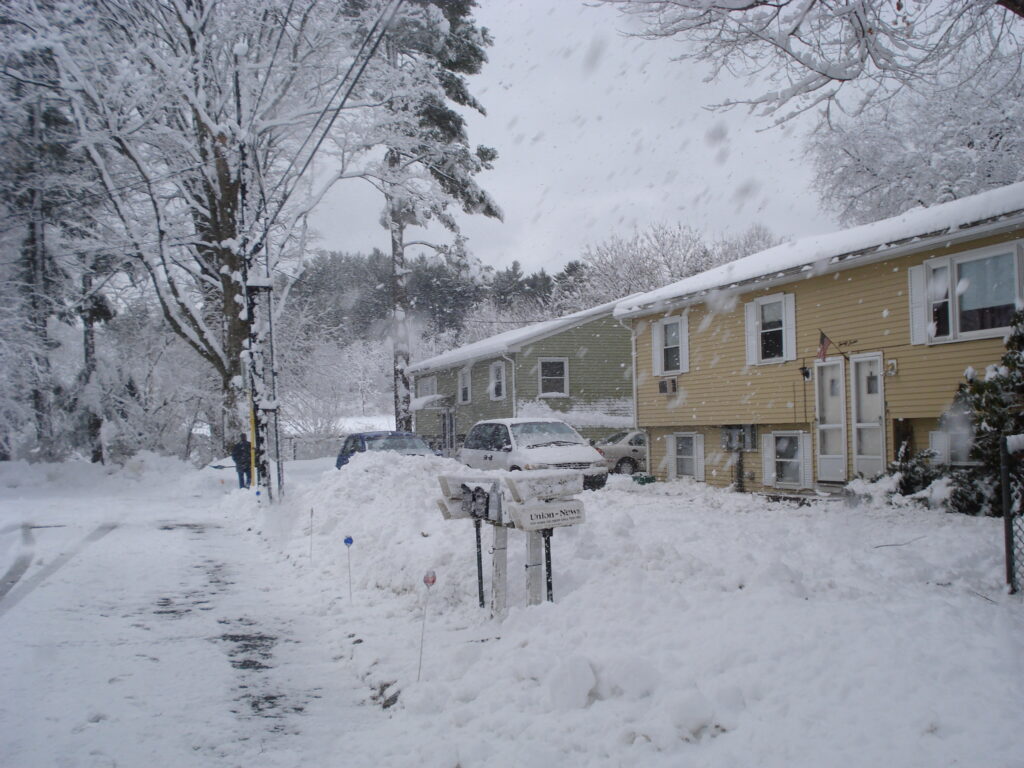
Rich was a member of the Faith in Action Team of the Pioneer Valley (FIAT), which had been formed in 2004 to oppose “gay marriage” in Western Massachusetts. FIAT was headed by another faithful Christian leader with a political orientation, Keith Davis, who also plays a major role in this story. It was at a FIAT speaker meeting in a Roman Catholic facility called Brightside where Pastors Cooley and Lively would commit to a ministry partnership. The speaker, Chanel Prunier, was a representative of Massachusetts’ largest pro-family policy organization, the Massachusetts Family Institute, then headed by the late, great Kris Mineau, former Air Force Colonel, who later became a good friend to our mission.
That Brightside meeting drew a pretty good crowd, including Pastor Cooley, and right from the very first moment when they began talking ministry strategy with Rich and Keith, all four knew something powerful had begun. There was instant agreement by Scott and Steve about the need for forming a group to pursue pro-active, redemptive ministry in Springfield. They carried on a meeting-long conversation at the back of the room, and by the evening’s end made a commitment to partner up for the work of Christ in the spiritual reclamation of the city.
Importantly, the Lord confirmed to Pastor Steve that his time to arise had come.
Our Team of Pioneers: The Redemption Group
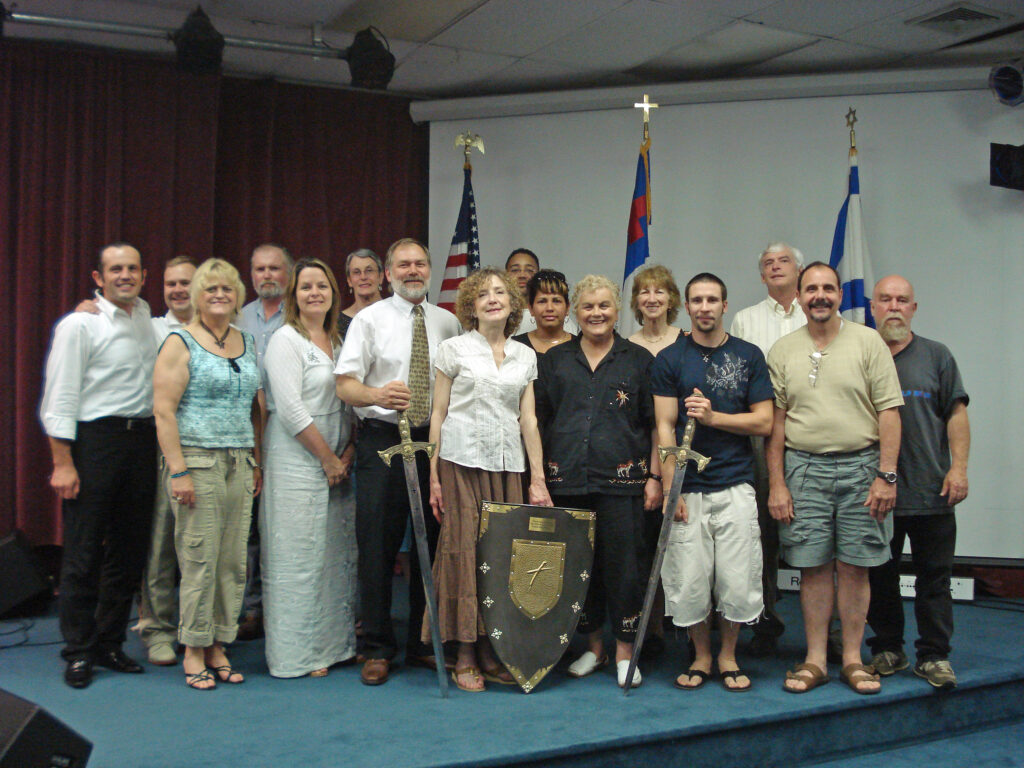
Because this book is really a personal testimonial, I will now shift to the first-person perspective.
As a member of the New Generation pastoral staff, I had the use of the church building and early in my ministry there began a weekly Sunday afternoon working group on the theme of re-Christianizing Springfield. We called it the Redemption Group. Some key members of the congregation were closely involved in this effort, especially in the early months, but for the most part the group was made up of activist-oriented pro-life/pro-family Christians from other churches in the Greater Springfield area.
From the first, Pastor Cooley was my main partner in the effort, despite being based in his own inner-city church. The New Generation leadership saw my role as expanding its membership to English-speaking believers, but my own vision was to use the church as a base for outward focused ministry similar to the work of its sister congregations in the former Soviet Union. That difference of expectation would limit my formal role on the pastoral team there to the original one-year term, but we worked through those issues with Christian love, remained good friends and allies in the subsequent years, and New Generation members played a major role in many of our outreaches and events during my seven years of direct leadership of the Redemption Project.
The first meetings of the Redemption Group were discussions on the spiritual status and needs of Springfield and the concept of redemption in general. What would the process involve? What would the city look like if we succeeded? How would we get started? What were the practical steps? What were the main obstacles?
Our Mission Field: The Redemption Zone
Early on we determined that taking on the entire city was unrealistic for the size and make-up of our group, so we decided to create a “Redemption Zone” which we would tackle first. We selected a fairly sizable area of mid-town Springfield surrounding New Generation Church and Pastor Cooley’s United Temple Church of God in Christ, set boundaries based on major streets, and then declared that territory to be our primary mission field.
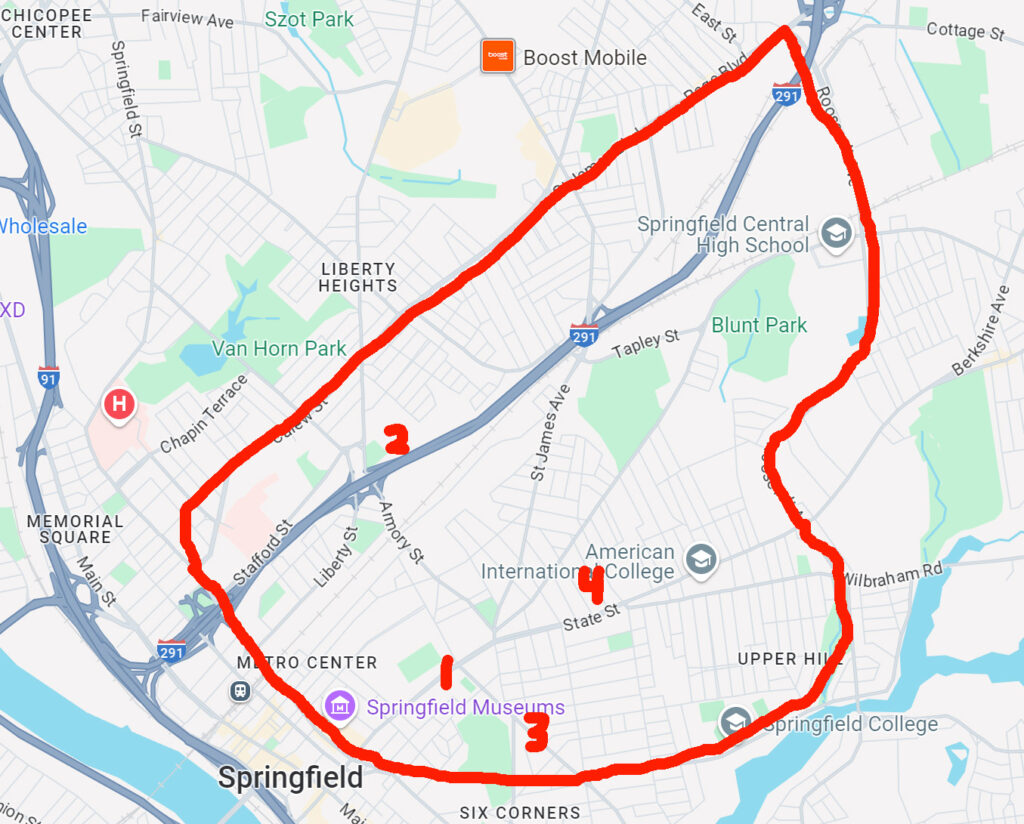
4) Redemption House.
Our Field Headquarters: Redemption House
Once we had defined the boundaries of the Redemption Zone, Anne and I decided to buy a home as close to the center of it as we could.
It was the middle of March, 2008. We had actually never owned a house before, in large part because of my nomadic tendencies. We had always lived in rented properties – in roughly two year stints – each time moving on to the next adventure. Our personal priorities were never oriented toward material possessions but toward experiences and the work of the Lord. Renting saved us from all the entanglements of home ownership. But in this case we wanted to own a house as part of the Springfield redemption process, and to live there, in “the hood,” to set a personal example of redemptive living. For that reason we intentionally looked for a house to own that would serve as the perfect “before picture” to eventually showcase alongside the “after picture” we expected to create by restoring and rehabilitating it with our own hands in full view of the people in the neighborhood.
From the worldly perspective it was a bold and dangerous move, but we had for years been living the missionary lifestyle all over the world, in many dangerous places. We knew the Lord had blessed our vision for the Springfield mission and had total confidence in His protection.
Even so, when we began the search for a house to buy we quickly learned that the center of the redemption zone was pretty much the most troubled part of the inner city. Driving through the neighborhood for the first time we saw that it was like some of the worst areas of Baltimore or Detroit – a formerly upper-class residential area that had fallen into serious depression and disrepair, with many signs of gang activity, drug trafficking and desperate poverty. Population-wise Springfield was very small compared to those cities, but there had been at least 20 street-murders there over the past year.
I don’t remember quite how we identified the house we bought as one that was for sale, but I will never forget “meeting it” for the first time at 60 Sherman Street in Springfield.
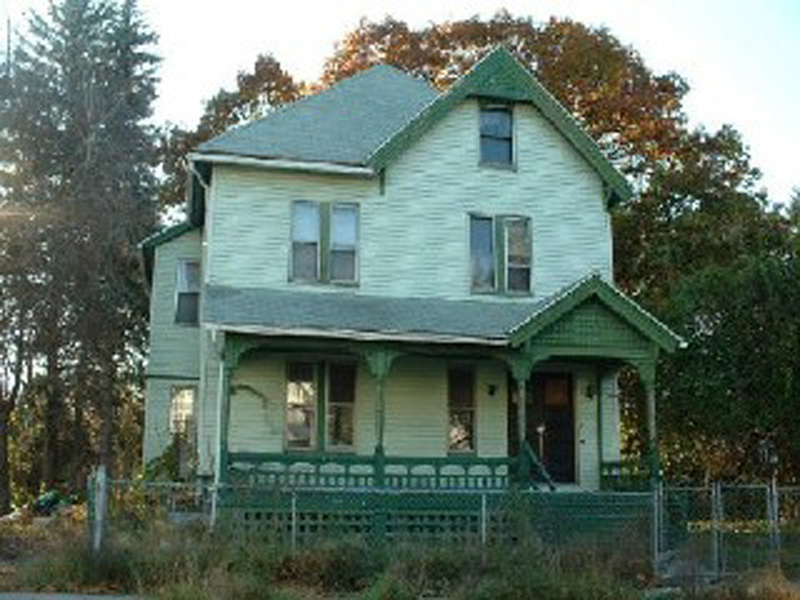
On paper it was quite a deal – an approximately 2800 square foot Victorian Farmhouse on a quarter-acre of land built in the 1887. It had “great bones” as they say, but was the victim of at least twenty five years of neglect and decrepitude.
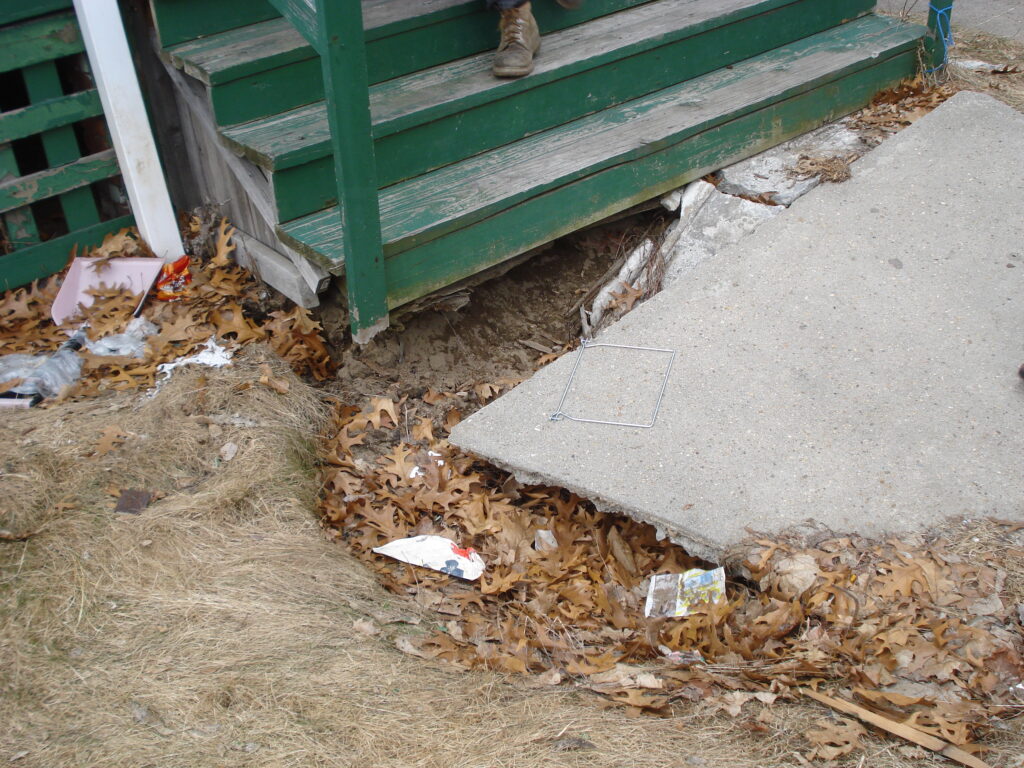
The first thing we noticed upon arrival to meet the realtor was that the sewer pipe running from the house to the street had long ago collapsed, creating a crater in the front lawn so big that the sidewalk to the front porch had collapsed into it.
Pieces of the top of the crumbling chimney had broken off, and the grounds were completely overgrown like a jungle. But the price was just $25,000, and (importantly to the issue of government non-interference in our renovation plans) it was not technically condemned by the city because it was a “repo” owned by a local bank. Plus, it was one street outside the official “historic district” and thus had all the (deeply faded) architectural charm (and potential) without the problem of micro-management by city officials regarding “historic district” restoration issues.
When we met the realtor on the front porch he expressed great reluctance at doing a walk-through, hoping we would just buy the place sight unseen at the newly dropped bargain price. We insisted on a walkthrough, but nearly changed our minds when he opened the front door and we were hit with a wave of unbelievable stench. It was then he revealed to us that a very “low end” squatter had been living there for some time, gaining entry through the broken cellar door accessible from the back yard.
The interior of the house was an incredible shambles, as if a tornado had swept through. We learned that the very last (short term) owners, a family, had bought the place during Barney Frank’s “sub-prime mortgage” debacle (which had triggered the national economic crash of 2008). People were being allowed to buy property far beyond their means then, with token down payments sometimes as low as zero. When the bank finally cracked down to foreclose on this particular place the owners just disappeared, leaving everything behind: furniture, clothing, housewares – even the Christmas tree and torn wrappings and boxes left over from Christmas morning – and then the looters had come through grabbing what they wanted and trashing everything else.

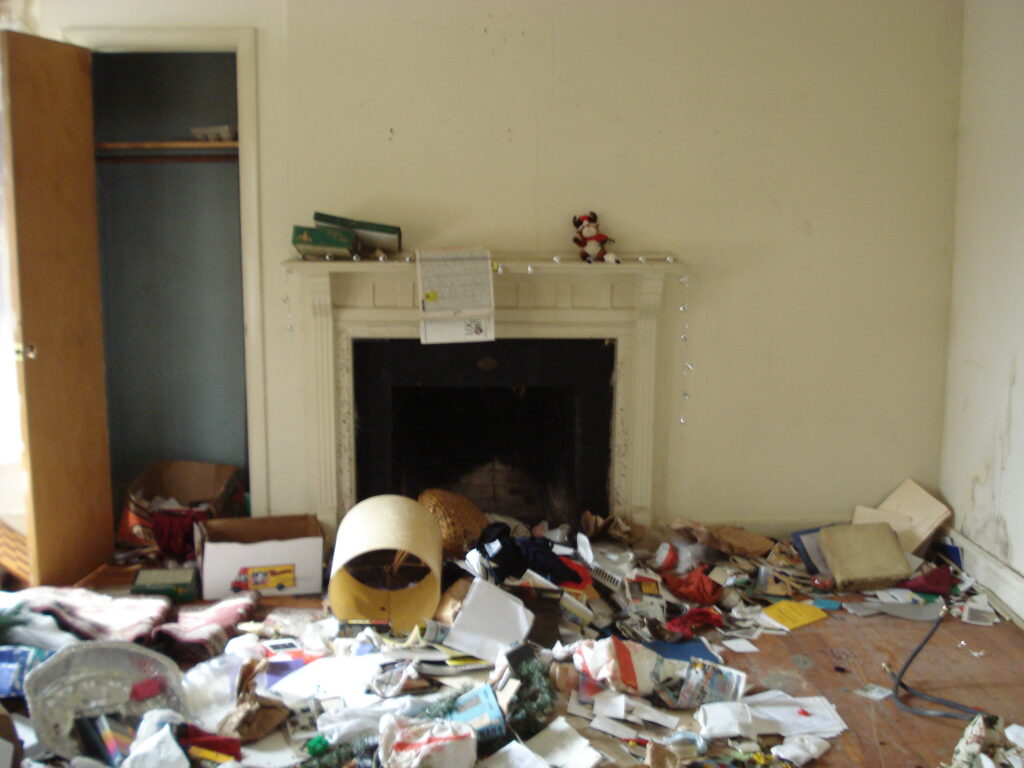
The house reportedly had served briefly as a crack den, before even the junkies moved out and a homeless Black Muslim squatter moved in and began systematically ripping out the walls and ceilings to steal the copper plumbing for money to buy drugs. He was close to the end of that process when we showed up.
Anne was pretty much speechless when we did the walkthrough, and the realtor held his nose and looked nauseous, but frankly I was pleased. “This is perfect,” I exclaimed, when we reached the kitchen, which was the worst room in the house. I had found my “before picture.” We made our offer on the spot, and as we drove back to our Westfield apartment we began making plans. When we got home we stripped off our outer clothes in the front porch so as not to defile our living space with the foul odor of the walkthrough which had literally infused our clothes.
The bank of course accepted our offer, being desperate to unload what they probably considered an un-sellable property and in a few short weeks we took legal and physical possession of it.
We named it Redemption House.
Anne, understandably, refused to move in until it had a working bathroom, so I made that my first priority. For my part, I wasn’t willing for her to be there until we had a guard dog for her protection whenever I wasn’t around. That impulse was strengthened when we learned there was a gang shooting on our corner the very day we took ownership. So we went to the animal shelter and both fell in love with a beautiful but ferocious looking jet-black pure-bred Chow Chow. We named him Genghis Khan and he came to live with us in Westfield even before the Springfield house was ready for her to move in.

Here is a gallery of “before pictures” and “after pictures” of Redemption House.
Now, before we go any further on the story of Redemption House, I’d like to set the stage for the larger Redemption Project we had just begun.
The Redemption Project “Before Picture”
Through most of the 20th Century, Springfield, Massachusetts was a powerhouse of commerce and industry, the home of numerous blue-chip corporations including Milton Bradley, Indian Motorcycles, Smith and Wesson, and the US division of Rolls Royce Automobiles. A prosperous city, its main streets were lined with impressive buildings of grand and stately design, and many large and beautiful churches of every denominational stripe, with the clear majority being Roman Catholic. The hub of the region, Springfield was surrounded by suburban towns that gave way to quaint, idyllic villages, rural farms and then heavy forests that famously blazed with autumn colors each year – and which fed the world-class paper industry whose riverside mills dotted the entire regional landscape. In the 1950s, Massachusetts epitomized the American dream, and Springfield was a very prominent gem in its crown.
But in the 1960s the Kennedy family leveraged its massive wealth from (alleged) coastal bootlegging and smuggling operations to take political power on the national stage, merging Massachusetts government with organized crime in a seemingly unbreakable model for perpetual Democrat control.
Although Kennedy scion President John F. Kennedy was very conservative by today’s standards, he was a liberal in 1960s terms, and the family never departed from the path to the left from that day to the present. America’s tax and spend liberalism, environmental extremism, and entitlement-based social welfare systems were largely pioneered in Massachusetts, and, of course, parasitically sucked the life out of the host. By the mid-1970s the inner-cities, including Springfield, saw their first waves of “white flight” away from leftist social policies and businesses began leaving the state to escape confiscatory taxes and burdensome over-regulation.
Springfield suffered terribly under liberalism and never recovered its footing. By the turn of the millennium it had become a mini-Detroit or Baltimore, its former industrial buildings rusted and crumbling and its streets of grand architecture as worn and wilted as the neighborhoods behind them.
Springfield hit it’s lowest point in the half-decade preceding the launch of our Redemption Project. It had already become “the Catfish Farm” because of liberal state policies, but it was also suffering under an extremely corrupt local government controlled or at least heavily influenced by Adolfo “Big Al” Bruno of the Genovese Crime Family.
In March of 2003, four former officials of the Springfield office of the Massachusetts Career Development Institute (a job-training program), including its Executive Director, Gerald Phillips, were indicted on charges of fraud and obstruction of justice. Their crimes included classic Mafia rip-offs such as “no-show” jobs and other pilferage of public funds. Importantly, Phillips was also the former chairman of the Springfield Police Commission. The group was convicted in July of 2005.
Those indictments were the first in a series of major setbacks for the Springfield mob and related government officials who created chaos for the city.
On November 23, 2003 “Big Al” was murdered outside the Our Lady of Carmel Social Club in Springfield’s South End by local rivals. He was immediately succeeded by Anthony Arillotta, whose brutal regime dominated the Springfield underworld for several years, but eventually (during our Redemption Project campaign) was sentenced to 99 months in jail for his part in it, after turning states evidence and becoming one of the most fruitful informants in the history of organized crime enforcement. Then in 2007, Anthony M. Ardolino, a former chief of staff for ex-Mayor Michael J. Albano, was sentenced to a year in federal prison on conspiracy and tax fraud charges. His two co-defendants – former cop Chester Ardolino (his brother) and bar owner Matthew Campagnari were also jailed on the same charges.
On the spiritual front, in February of 2004, Springfield’s Roman Catholic Bishop, Thomas Depre became the then-highest church official in America to be indicted for pederasty (homosexual pedophilia). He then resigned but was not prosecuted because the statute of limitations had run.
Springfield’s Protestant churches were heavily self-segregated by race, and the social liberalism that had corrupted most spheres of Massachusetts society had certainly not spared the “mainline” congregations of the local Christian community who were among the very first nationally to fly the rainbow flag of LGBT conquest.
On the economic front, Springfield was $40 million debt and spared from formal bankruptcy only by the direct intervention of the state, in the form of a Finance Control Board appointed by Governor Deval Patrick.
On top of all that, Forbes Magazine had recently declared Springfield “One of the ten fastest dying cities in America.”
Thus, the Springfield “before picture” was as dramatic on a municipal scale as Redemption House was in microcosm.
The Redemption House Beachhead
The fight to redeem a post-Christian city is necessarily a spiritual battle, but the effects of spiritual warfare are almost always manifested in the physical world. Redemption House thus represented a physical “beachhead” in the war for the spiritual redemption of Springfield, and its success was largely measured by visible changes, first in the immediate neighborhood and then the larger Redemption Zone.
My very first act on the property was to find and meet the squatter, Yusef. In keeping with the redemptive theme (and not knowing then that he was responsible for stealing all the copper plumbing) I didn’t demand that he leave, but instead offered him the job of caretaker until such time as Anne and I moved in. I then began paying him for manual labor on various tasks.
It took more than buying a house in the hood to establish that beachhead. Like the landing at Normandy, the first task was claiming the ground at the landing site before spreading out – and that was a job for a spiritual storm-trooper, not the regular army. The enemy had total control over that neighborhood and its streets were held and roamed by dangerous men. There was a heavy dark cloud of spiritual oppression that hung in the air like a Satanic fog. But the Lord had given me special skills in survival and strategic problem-solving during my years on the streets as an alcoholic and drug addicted drifter. He then honed those skills to a fine edge for more than twenty years after I became His servant in 1986. Thus, in 2008, I was not intimidated by the task or the people and moved in immediately to take possession of Redemption House — like Joshua crossing the Jordan. (All glory to God for any good thing in me.)
It took several weeks to make Redemption House habitable. I had the added incentive of getting my wife back as soon as I could ensure her a working bathroom. (I was using the restroom at the McDonalds down the street.) The first step was clearing 25 years of accumulated trash out of its four floors (including a full basement and attic, both of which were piled high with debris). There was so much trash we filled two 40-yard dumpsters (the largest size made) even after sorting out all the recyclables and re-usable items like tools and furniture. Even so, to fit everything in we packed the dumpsters so tightly I began joking that we almost created a “black hole.”
***Pics of Redemption House during the clean-out phase.
Anne helped during the daytime, as did Yusef who turned out to be a reasonably good worker, and who responded very positively to my fatherly style. Friends from the Redemption Group and New Generation also helped. To solve the plumbing problems, I hired an old (alcoholic) Black journeyman plumber named Charlie Hawley. He was willing to work pretty cheap and to let me work with him under his license and supervision to keep costs down (my first career had been in residential repair and remodeling for 12 years). Between the two of us we got that major task done and passed the inspections quite rapidly.
Once we cleared the plumbing hurdle, the next big item was to retrieve our essential furniture and household goods from California where we had put it in long-term storage in early 2007 before starting our speaking tour in Russia and Eastern Europe. We’d actually given away most of what we owned leading up to that adventure, but the rest of it nevertheless filled a medium sized U-Haul. I flew out to Southern California, loaded up the truck myself, and drove it back to Springfield in a single week.
Unfortunately, while I was gone, Anne was alone in the house (during the work days) and Yusef backslid from his character improvements under my discipleship by stealing money from her purse. She actually confronted him about it (she’s a brave lady) and of course he denied it. However the very next day he got arrested for shoplifting at a supermarket and hauled off to jail. The long arm of the Lord divinely protected her once again as only He can do.
Soon we were moved in as a couple and the work could expand beyond the boundaries of our property. Already we were having a powerful impact on the neighborhood. Many people stopped to chat across the fence and we always explained our redemptive missionary purpose. Most were Black, a few were Hispanic (mostly Puerto Rican) and all were greatly pleased and impressed. Some months later one particular Black man, James, whom we recruited to help us move a piano someone had donated to us – summed it up best when he exclaimed incredulously as we pulled into the driveway “You live in the HOOD??!!!”
James had known us for a few weeks in a ministry context but assumed we lived in the suburbs and commuted in to the inner city. He was literally astonished that we (non-poverty-stricken people who could choose to live anywhere) actually chose to live in that house in that neighborhood. Our choice conveyed a genuineness which all by itself ministered to the hearts of our neighbors and changed discouragement into hope.
Reclaiming the Streets
*** Pictures of outreach group
*** Our first outreach June 9 2008 Outreach, gathering and BBQ
Once our spiritual beachhead was secure we began the process of evangelizing the neighborhood. At first it was just Anne and I, going out at random times with gospel tracts as our schedule allowed. But eventually we established a regular Tuesday Night Outreach that took on the challenge as a group. Word spread among the missionary-minded Christians of Greater Springfield and a few of them began to show up at Redemption House on Tuesday evenings to join us. Sometimes we had just five or six people, but other times we had as many as twenty. We always took our our regal and beautiful black-maned Chow Chow, Genghis Khan along, who naturally drew people to him like a butterflies to a flower.
Our system was simply to walk along both sides of the street as a group and pass out gospel tracts and ask people if they needed prayer. Whenever anyone said yes, one or two people would focus on them while the rest of the group moved on. We kept busy on slow nights by dropping tracts door to door.
In the early days, the most common reaction we got from people was shock that we were not afraid to be on the streets at all. One old black man’s comment was typical. He was sitting in his car in the parking lot of the local drug store where there had been a recent shooting or robbery. When I went to his window to pass him a tract, he rolled it down and said somewhat scornfully “What the h*** are you doing out here?” When I passed him a tract and told him we were evangelizing the neighborhood, he replied “Good luck with that” in a highly skeptical tone.
But our efforts paid off fairly quickly and dramatically. By the middle of summer the entire character of the neighborhood had changed, and by the second or third year of outreaches other outlying churches began doing their own similar outreaches.
Plus, many people accepted the Lord during those events. I was surprised at how many inner city people – a high majority – actually wanted to take our tracts and to be prayed for. Unlike the suburbs where the most common response to an evangelical encounter is a stop-right-there raised palm and a curt “No thanks, I’m good,” most inner city people would stop to talk and listen. I refined my personal method during those first few months and was literally, regularly leading people to a prayer of acceptance of Christ in less than five minutes.
It went something like this:
Me: If you died today would you go to heaven or hell?
Them: I think I’d go to heaven.
Me: Why do you think that?
Them: Because I’m a pretty good person.
Me. It doesn’t work that way because you can’t be good enough to qualify. God is so pure and holy that no sin – even the tiniest bit – can come into His presence. Even if you only sinned one time your whole life you would get burned up just by coming near Him.
That’s why we need Jesus, because He was the only perfect and sinless man. He died on the cross to pay for all the sins of the world so that people could come to God based on His perfect life and not their imperfect one. When you belong to Jesus, He cloaks you in His perfect holiness and that’s all that God sees when you come near Him because all your sins have been paid for by His son.
That’s why Jesus said in the Bible in John 14:6 “I am the way, the truth and the life, no one can come to the Father except through me.”
Would you like to accept Jesus right now as your Savior so you can go to heaven?
Them. Yes, I would.
Me. Ok, its very simple, just pray these words after me…
We would then pray the sinners prayer, I would give them a copy of the Gospel of John (which we bought by the caseload), showing them where to find John 14:6, and urge them to find a home church.
One time I was criticized by a young man who joined our outreach that week, who insisted I had a duty to follow up with discipleship of those I led to Jesus. I replied that all evangelism really boils down to encouraging someone to answer Christ’s knock on their door (Revelation 3:20). It is then He who does all the work of converting that person to Himself and guiding his future path of sanctification. Unless He specifically assigns you a part in that discipleship process, you really have no further duty, although as a practical matter, discipleship of new believers is a valuable congregation-building tool. We weren’t yet at that stage.
Ministry at Redemption House
While our personal church life was grounded in my role as a pastor at New Generation, the ministry work Anne and I were doing in our neighborhood attracted numerous believers who wanted fellowship with us outside the context of a formal church. As it turned out, several of these people shared a common life challenge in the area of mental health.
Now, both Anne and I were raised by parents with mental health problems. My Dad and her Mom were mentally ill and our lives were heavily impacted by the complications this imposed on our lives as children. Anne in particular was dismayed that there was very little in the way of ministry to mentally ill people in the modern church, and so she suggested that we start a Christian prayer meeting at Redemption House on that theme for people who struggled with mental health issues and their friends and families.
As we began meeting weekly on that theme, and held other ministry meetings outside the context of our New Generation partnership, the thought of acquiring a multi-use facility of our own, dedicated to the Redemption Project arose and became a regular part of our conversation.
The Coffee House Building
One day in the late summer or early fall of 2008 I was driving down State Street (the main east/west thoroughfare in Springfield) from our close-in midtown home base to the city center, I spotted a brand new “For Sale” sign on an historic three-story brick building directly across the street from the historic Springfield Armory – established by General George Washington during the Revolutionary War. Reportedly, he had stood on that hillside site looking down on the mighty Connecticut River and its shipping traffic and proclaimed “This is a hill that cannot be taken.” Upon his order, transport of British prisoners-of-war past that site was henceforth forbidden, and soon a formidable arms-manufacturing factory arose upon it, comparable only to the one at Harpers Ferry, West Virginia.
In 2008, other than an on-site museum preserving the armory’s artifacts and history, most of the complex had become a Community College using the same historic buildings that had continually produced weaponry into the mid-1970s – the entire sprawling complex ringed by a tall iron fence.
Across the street from the Armory was one of Springfield’s oldest blocks of commercial buildings, the Gunn Block, initially anchored by Elisha Gunn’s store built in 1830, selling coffee, rum, molasses, sugar, and spices. https://springfieldpreservation.org/gunnblock/ Supposedly, that store replaced a tavern on the same spot which had housed General Washington during his visits. Just a few doors down on the same block was another three-story brick structure of the same vintage, essentially three separate buildings sharing common dividing walls. We bought the one closest to the Gunn building: 453-455 State Street.
The first floor had for decades been a television repair shop, but had been made obsolete by advances in electronics technology. Above were two residential floors with one large apartment on each floor accessible by stairs at the front and back. The back access included large porches that overlooked a small parking lot. We shared an alley/driveway with a Chinese take-out restaurant next door.
As the neighborhood had grown poorer and more dangerous over the years the storefront took on the appearance of a fortress. By 2008 it looked like a scene from Mad Max or Escape From New York with yellowed plexiglass windows behind thick aluminum bars, and a front door of heavy steel mesh.
When I met the realtor there for a tour of the interior I told him our purpose was to found a Christian street mission and he informed me the sellers were strong Christians who hoped the building would be used for ministry. I made an offer for $85,000 on the spot and later that day they accepted it without negotiating for a better price. They dropped it another $2500 when we encountered some unexpected issues from the city inspections.
The purchase and sale agreement we signed is dated September 30, 2008 – which just happened (by God’s arrangement) to be the date of the Feast of Trumpets on the biblical calendar, the first day of that seven year Shemitah cycle: a fact that would become very significant to us later on (as I will relate).
The money for the State Street building came from a fund I had set up while in law practice in Southern California. I only became a lawyer to have better skills to fight the culture war so during that several year side-track in private practice to lay a better financial foundation for my family and our future mission work, I kept my ministry organization, Abiding Truth Ministries, alive. I didn’t need my ministry salary then so I donated it to a special stock brokerage account I called the Pro-Family Charitable Trust (PFCT) to grow the principle as fast as possible while giving away the interest and dividends to like-minded ministry groups. I taught myself how to invest and then grew an initial $50,000 to around $200,000, giving away more than $25,000 in grants between 1999 and 2007.
In the stock market crash of 2008, we lost about a third of the PFCT fund, so we liquidated it, bought the State Street building from the proceeds and used the balance to upgrade and renovate the building for ministry use. Our total investment was about $150,000, using up all the remaining balance of the PFCT. In the meantime I had legally formed and established Redemption Gate Mission Society as a church, so when the building was finally finished in 2010, ATM donated it to Redemption Gate.
In Massachusetts every church is allowed two tax exempt parsonages for clergy housing, so we designated the two apartment floors as parsonages and got tax exempt status for the entire building. Since we owned it free and clear, owed no property taxes, and had no paid staff, only volunteers, we were able to run the mission on less than $25,000 per year all-in (the biggest budget items being the fire insurance and winter heating). This allowed us to offer all of our goods and services to the community for free and to survive on small donations from our support base.
We used the parsonages to provide free housing for homeless and other disadvantaged people willing to serve the mission with whatever skills they possessed – becoming essentially lay-ministers. Often these residents were actual trained clergy who used the building to hold their own religious services – with as many as four separate small congregations operating there on a weekly schedule.
This multi-use ministry was easily accomplished because we had designed the first floor as a church in the form of a coffee-shop called Holy Grounds Coffee House, and made it available to anyone with a Christian ministry purpose.
The Renovation Phase: 2008-2010
As I mentioned previously, my first career was in the building trades: I started with a one-man handyman service in Portland, Oregon in 1977 which I grew into a ten-contractor one-call-does-it-all building trades collective called Portland Handyman. I thus had the basic skills to personally handle most of the tasks related to the renovation of both Redemption House and the coffee-house building and I actually did most of the work on both properties personally in 2008 and 2009. I turned the basement of Redemption House into a fully equipped workshop and materials processing center and devoted most of my time to renovations at both locations. But I had a growing pool of volunteers to bring in on tasks and by 2010 was able to delegate many things at the coffee house building to others.
My first main helper was Anthony Wirth, a strong Christian young man who trained independently in pastoring during our sojourn together, and later founded The City Church in Springfield. His was actually the first independent congregation to use the coffee house building. I had met Anthony when I had my law practice in Temecula, CA and he was brand-new to Christian ministry. He had learned I was a local Christian lawyer and cold-called me one day seeking funding for a ministry to start Christian clubs in high schools. I was so impressed by him that when I needed to find someone trustworthy to run my ministry office while Anne and I were off on our mission tour in the former Soviet Union I hired him to do it.
One day, after that tour had ended and Anne and I had relocated to Springfield, Anthony called me from California to say that he and his wife were thinking of going to San Francisco to start something similar to what Anne and I were doing. I urged him to consider Springfield as an alternative, and as it turned out, his wife Nichelle’s grandmother was from Springfield so they decided to join us there.
In my investment research for the PFCT I had learned about holding real estate in retirement accounts, and so, to further the goal of helping the Wirth family get a good start in Springfield, and to put Anne’s small retirement savings to best use, I bought her a nice house in a family-friendly neighborhood (at a super cheap price) to rent to them at an affordable rate, and offered it to them as a rent-to-own. It was the bottom of the local real estate market then and we got a big house in good condition suitable for a growing family, which they did eventually buy at our pre-set price. We doubled Anne’s investment and at the same time gave the Wirths a nice homestead with significant built-in equity. All this was the Lord’s blessing over the fruit of our joint ministry.
By 2011 when the first major wave of media and political attacks on me for my past pro-family ministry began to hit, Anthony’s independent ministry efforts had already moved him out of our orbit and onto his own church-planting trajectory with his own team. To protect him from collateral damage I stopped involving him in our mission efforts and from mentioning our past history. As far as I know, he escaped any serious fall-out from it. Indeed, this is the first time I’ve publicly mentioned it since then.
(Anthony had not been significantly involved in my pro-family work anyhow, and frankly, neither had I because my plan in moving to Springfield was to retire from the culture war and pursue more traditional ministry goals. But God had other plans for me on that score, as I will soon relate.)
Getting the coffee house building in shape to serve our ministry vision was no small challenge, and eventually required the involvement of professional builders. We wanted our face to the world to be as inviting and attractive as possible, and that meant remodeling the storefront and entryway. We were introduced to a Christian contracting company AlTek that largely donated its skills and labor to accomplish that. We demolished the old, protruding storefront and moved the new one back flush with the front wall, putting in a new door and three designer windows. After that, everyone agreed we had the best looking place on the block and, best of all, the building itself became a witness to Christ.
^^^
We created a narrow brick patio where the protrusion had been which spelled out our ministry motto “Trust Jesus” in darker-colored bricks.
^^^
On the alley side we replaced a tall window with glass blocks and used darker ones to form a cross in the center of it.
^^^
Inside we replastered the walls and included many small **Ichtus fish symbols and a copy of Michaelagnelos famous depiction of Creation
^^^
The existing ceiling was of antique decorative tin tiles which we painted gold to represent the underside of the pavement of Heaven as described in Revelation 21:21.
^^^ We had an old analog clock on the wall deliberately stopped permanently at 5:22 with the word Galatians on a tag across the bottom. Galatians 5:22-23 lists the fruit of the Holy Spirit in a Christian life: “But the fruit of the Spirit is love, joy, peace, patience, kindness, goodness, faithfulness, gentleness, and self-control.” That passage came to largely define the spiritual atmosphere at Holy Grounds Coffee House.
To meet city code for a coffee shop we needed to add a public restroom, but decided to add two gender-specific ones mostly to make the space more respectful to the ladies. But they also served a ministry purpose because the many homeless people in the area knew they always had welcoming restrooms to use, even when local businesses tried to keep their own facilities off-limits to non-customers.
^^^
Upstairs we created a Prayer Room, with the intention of having a 24-hour prayer center, but ended up needing it for housing people in crisis situations.
^^^
Outreach Projects During the Renovation Phase
In terms of outreach ministry, Anne and I had hit the ground running in 2008. Our purpose was to “reclaim Springfield for Christ” following the model we had seen in practice by the New Generation churches of the former Soviet Union. The most impressive ministry they did annually in their headquarters city of Riga, Latvia was Family Day – a huge city-wide celebration of the natural family, true marriage and gender normalcy.
^^^ Riga Family Day
- Springfield Family Day
The first project we launched was thus our own Springfield Family Day that we scheduled for the summer of 2009.
^^^ Building with Banner
That first Family Day took place in Blunt Park and was only possibly because of the efforts of the New Generation congregation.
^^^ Pics of that event and NG people
- The March for Jesus
While the primary purpose of Family Day was to serve the needy in the inner-city while affirming the importance of family to them, we also wanted to get local Christians more involved in public expressions of their faith, and more engaged in cooperation across denominational lines. That was the initial motivation for the March for Jesus, which we learned had once been a Springfield tradition years before.
Redemption Gate’s first March for Jesus was …
By 2011 the renovation phase was done, and we had three years of inner-city ministry under our belts.
2011-2015 The Spiritual Warfare Phase
Back in 1986 when I was a baby Christian in Portland, Oregon there was a person or persons who started writing “Trust Jesus” in chalk all over the city – on the sidewalks, the sides of buildings, and just about anywhere the message would stand out. I was very impressed by that, so when it came time to develop a motto for our own urban ministry, “Trust Jesus” instantly sprang to mind.
The New Generation Strategy
As mentioned briefly in the introduction, my inspiration for asking the Lord for a city to re-Christianize came from my experience working with the New Generation Church in the former Soviet Union. New Generation, based in Riga, Latvia, had a unique ministry emphasis on “taking the cities for Christ” through good works and evangelism, with special focus on shaping public policy through influence in the business and political spheres of society. My role in their strategy was to advocate for biblical social policy on family issues through lecture in universities, print and broadcast media interviews, and meetings with church, business and political leaders. I was already fairly well known in the Russian-speaking world as a leader of the American pro-family movement and co-author of The Pink Swastika: Homosexuality in the Nazi Party (whose thesis was very controversial in the US, but very well received in Russian and Eastern Europe). The local NG churches used my visit and quasi-celebrity as a focal point to draw these leaders together in conference or seminar settings and recruit them for community-enhancing projects. The most impressive and impactful of these projects was a major event in Riga, itself, called Family Day.
*** pics from Family Day Riga [link to gallery]
Our first community-wide project for the Redemption Zone was thus a local Family Day event, sponsored by New Generation and Pastor Cooley’s United Temple Church of God in Christ. Thereafter we held a Family Day event annually.
*** pics of Spfld Family Day [link to gallery]
mental health group
A Jungle Becomes a Garden
, including especially a wonderful Christian young man named Ivan from New Generation church.

